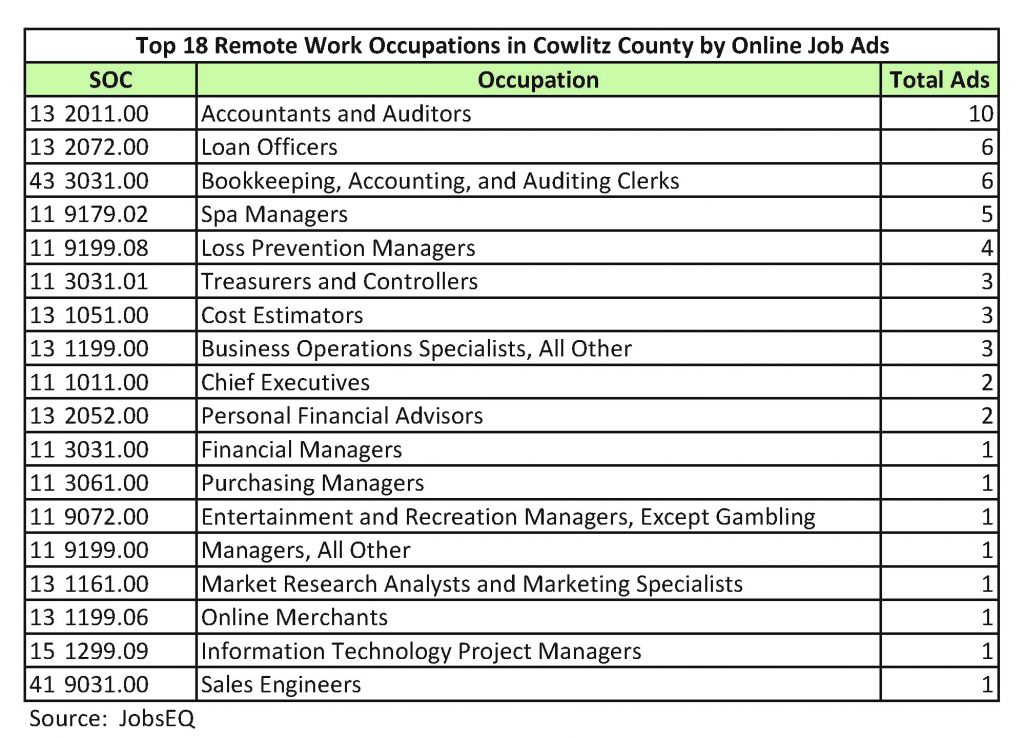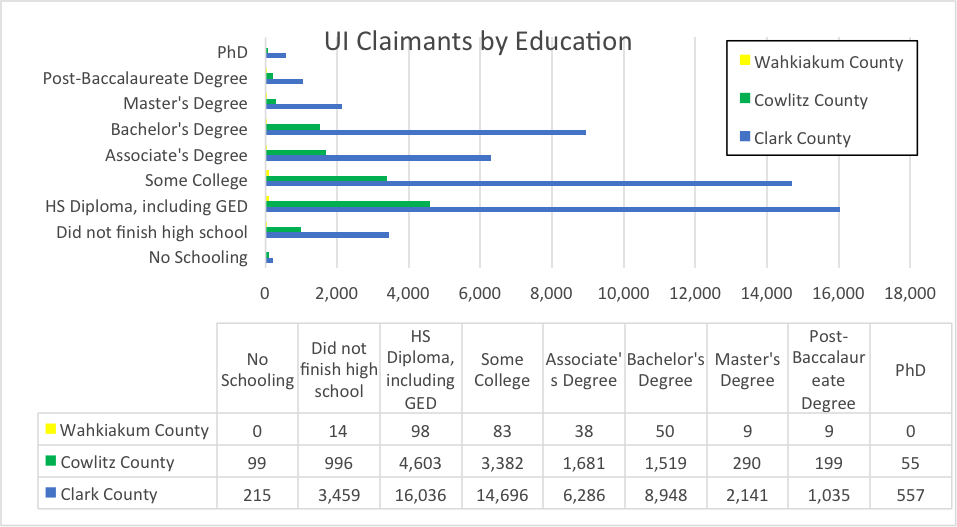In response to the COVID-19 pandemic, working remotely has become the “new normal” for many. A study by Chmura Economics & Analytics, JobsEQ leveraged two datasets, American Time Use Survey and Department of Labor’s O*NET, to analyze jobs that can be done remotely.
From these identified occupations (defined at the 6-digit NAICS level) we compiled analytics of what this looks like in the Southwest Washington region. See the tables below.

Remote Work Occupations Currently Hiring
From the identified “remote” occupations, we wanted to see which currently had job openings. In the last 30 days, the top online job postings in Clark County have been software developers, management analysts, accountants/auditors, and network/computer system administrators.

In Cowlitz County, the top online job postings for remote work occupations in the last 30 days included accountants and auditors, loan officers, and bookkeeping/accounting and auditing clerks.

Education Requirement of Remote Working Occupations
Many of these remote occupations require a higher degree of education. In Clark County of those employed in these occupations, 77 percent have an associate’s degree or higher and 87 percent of these jobs require a two-year degree or higher. In Cowlitz County of those employed in remote working occupations, 86 percent have some college or higher and 85 percent of these jobs require at least a bachelor’s degree.
The table below shows initial unemployment claims by education level in Southwest Washington between March 1 and July 18, 2020.
Individuals with a high school diploma or some college saw higher rates of unemployment than those with associate’s and higher degrees; further evidence of the importance of post-secondary education to continued employment.

Gender and Remote Work Positions
The gender breakdown for many of the remote work jobs tends to be almost evenly split between males and females in our three counties. However, more women than men are employed in lower-paying jobs like bookkeeping, accounting and auditing clerks, while more men hold the highest-paying jobs as software developers and software quality assurance analysts and testers.
Unemployment Rate During COVID-19
The unemployment rate in Clark County in March 2020 was 4.4 percent. In June the unemployment rate was 10.2 percent. In Cowlitz County, the unemployment rate before COVID was 5.7 percent. By June the rate was 10 percent. Wahkiakum County in March was at 6.9 percent and in June had increased to 9.4 percent. Unemployment numbers due to COVID-19 far exceed the number of those unemployed during the Great Recession.
In a June 30, 2020 blog post, “Microsoft launches initiative to help 25 million people worldwide acquire the digital skills needed in a COVID-19 economy,” Microsoft calculated global unemployment in 2020 may reach a quarter of a billion people. And says the U.S. Congressional Budget Office estimates the country may witness a 12.3-point increase (from 3.5 percent to 15.8 percent) in the unemployment rate, equating to more than 21 million newly out-of-work people.
While we are months away from knowing the true impacts of COVID-19 on where and how we work, it is evident that increased education and digital skills are necessary not only to gain employment but to retain employment. Individuals with digital-enabled jobs simply plugged in at home and kept working.
The ability to work remotely increases opportunities and provides employment stability. This points out a need to increase the digital skills of all workers, even those not in technical or information technology positions and further underscores the importance of having reliable internet access in rural communities.
Local Strategy
In Cowlitz County, where the Chmura Remote Work Index is 75.96, well below that of the Portland-Vancouver metro region which is 105.35 (an index of 100 means the region has the exact same remote work mix as the nation), WSW is piloting a virtual training program with CompTIA, a nonprofit trade association, issuing professional certifications for the information technology industry.
CompTIA is considered one of the IT industry’s top trade associations. CompTIA A+ Computer User Support Specialist Training is one of America’s most successful workforce programs – on average, 88 percent of students graduate and 86 percent of graduates move into paid IT jobs with local companies.
In Cowlitz County, CompTIA’s strategy is to move program graduates into home-based computer user support jobs with top companies such as Amazon, TEKsystems, US Bank, BridgeTech, Atmosera, and Cook Security Group. Median earnings for computer user support specialists in the U.S. are $51,900 annually and in Washington $62,600 annually.
Additionally, to further promote remote work opportunities for residents of Southwest Washington, WSW is exploring a new partnership with Career Karma, an app that helps match students to coding boot camps, provides career coaching and mentorship and guaranteed placement for graduates. Career Karma partners with training vendors throughout the U.S. and uses Income Share Agreements (ISA’s), an alternative to student loans. Students are required to repay a portion of their education upon placement into a living wage job. Careers include software developers, web development, data science, user experience design and digital marketing.
We’re also working with local businesses that are investing in enhancing the skills of their workers, especially those in positions facing automation. Companies have a role to play not only in training their employees but in encouraging lifelong learning and making training and education available on the job. Our business services team can help! Contact them today.



